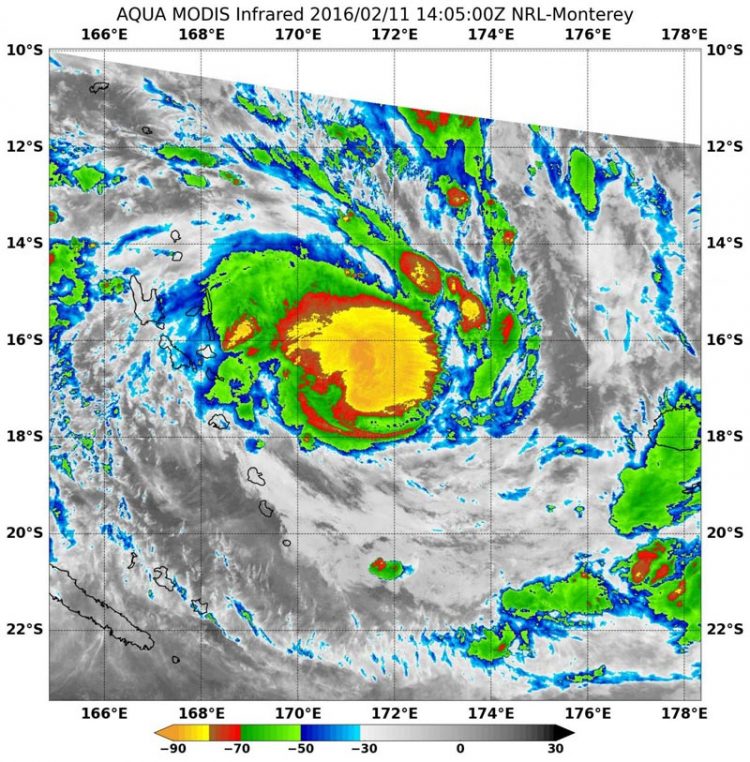NASA sees Tropical Cyclone Winston form

On Feb. 11 at 1405 UTC (9:06 a.m. EST), the MODIS instrument aboard NASA's Aqua satellite saw coldest cloud top temperatures near -80F/- 62.2C and strongest storms circling the center of Tropical Cyclone Winston. Credit: Credits: NASA JPL, Ed Olsen
On Feb. 11 at 1405 UTC (9:06 a.m. EST), the MODIS instrument aboard NASA's Aqua satellite saw coldest cloud top temperatures near minus 80 degrees Fahrenheit/ minus 62.2 degrees Celsius indicating very powerful storms circling the center of Tropical Cyclone Winston.
Those powerful storms are spiraling into the low-level center of circulation. Storms with cloud tops that cold and high in the troposphere have been shown to generate heavy rainfall.
Infrared data also showed that sea surface temperatures were near 31 degrees Celsius warm enough to keep fueling and strengthening the storm. Tropical cyclones need sea surface temperatures of at least 26.6 degrees Celsius (80 degrees Fahrenheit) to maintain intensity.
At 1500 UTC (10 a.m. EST), Winston's maximum sustained winds were near 55 knots (63.2 mph/101.9 kph). It was centered near 16.7 degrees south latitude and 171.6 degrees east longitude, about 398 nautical miles west of Suva, Fiji. Winston was moving to the south-southeast at 6 knots (6.9 mph/11.1 kph).
Winston is forecast to move south and continue between Vanuatu to the west and Fiji to the east while intensifying to 105 knots (120.8 mph/194.5 kph).
Media Contact
All latest news from the category: Earth Sciences
Earth Sciences (also referred to as Geosciences), which deals with basic issues surrounding our planet, plays a vital role in the area of energy and raw materials supply.
Earth Sciences comprises subjects such as geology, geography, geological informatics, paleontology, mineralogy, petrography, crystallography, geophysics, geodesy, glaciology, cartography, photogrammetry, meteorology and seismology, early-warning systems, earthquake research and polar research.
Newest articles

Properties of new materials for microchips
… can now be measured well. Reseachers of Delft University of Technology demonstrated measuring performance properties of ultrathin silicon membranes. Making ever smaller and more powerful chips requires new ultrathin…

Floating solar’s potential
… to support sustainable development by addressing climate, water, and energy goals holistically. A new study published this week in Nature Energy raises the potential for floating solar photovoltaics (FPV)…

Skyrmions move at record speeds
… a step towards the computing of the future. An international research team led by scientists from the CNRS1 has discovered that the magnetic nanobubbles2 known as skyrmions can be…




















